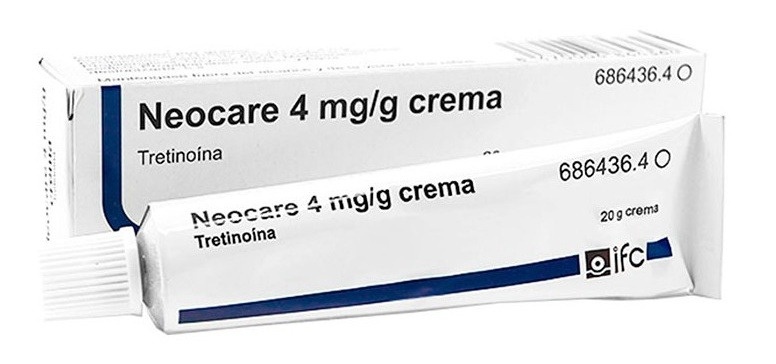

НЕОКЕА 4 мг/г КРЕМ

Спросите врача о рецепте на НЕОКЕА 4 мг/г КРЕМ

Инструкция по применению НЕОКЕА 4 мг/г КРЕМ
Введение
Инструкция: информация для пользователя
Неокар 4 мг/г крем
Третиноин
Прочитайте внимательно всю инструкцию перед началом использования этого лекарства, поскольку она содержит важную информацию для вас.
- Сохраните эту инструкцию, поскольку вам может потребоваться прочитать ее снова.
- Если у вас есть какие-либо вопросы, проконсультируйтесь с вашим врачом или фармацевтом.
- Это лекарство было назначено только вам и не должно быть передано другим людям, даже если они имеют те же симптомы заболевания, что и вы, поскольку оно может нанести им вред.
- Если вы испытываете побочные эффекты, проконсультируйтесь с вашим врачом или фармацевтом, даже если это побочные эффекты, которые не указаны в этой инструкции.
Содержание инструкции
- Что такое Неокар крем и для чего он используется
- Что вам нужно знать перед началом использования Неокар крема
- Как использовать Неокар крем
- Возможные побочные эффекты
- Хранение Неокар крема
- Содержание упаковки и дополнительная информация
1. Что такое Неокар крем и для чего он используется
Неокар - это лекарство, которое относится к группе лекарств, называемых местными противоакнеическими средствами.
Неокар - это крем, который показан для местного лечения легкого и умеренного акне.
2. Что вам нужно знать перед началом использования Неокар крема
Не используйте Неокар крем:
- если вы аллергичны (гиперчувствительны) к активному веществу или любому другому компоненту этого лекарства (включая те, которые указаны в разделе 6).
- если вы беременны.
- если вы планируете стать беременной.
- если у вас есть семейные или личные антецеденты эпителиомы кожи (типа рака кожи).
- на участках кожи с ранами, абразиями и экземой (заболеванием кожи с воспалением, покраснением и экссудацией), поскольку это может вызвать раздражение кожи.
Предостережения и меры предосторожности
Проконсультируйтесь с вашим врачом или фармацевтом перед началом использования Неокар крема.
Раздражение, вызываемое этим лекарством, связано напрямую с его эффективностью и исчезает при уменьшении частоты нанесения. В первые недели лечения может наблюдаться кажущееся увеличение симптомов и признаков раздражения. Эта реакция является нормальной, поскольку она связана с ускоренной элиминацией микрокомедонов, которые находились в стадии формирования в более глубоких слоях кожи.
В случае постоянного или сильного раздражения ваш врач оценит возможность прекращения лечения.
Избыточное нанесение Неокар крема не улучшает результаты лечения и может даже вызвать сильное раздражение с покраснением, шелушением, зудом и т. д.
Во время лечения Неокар кремом следует быть осторожным с одновременным использованием других лекарств, которые могут вызывать местные раздражения, особенно тех, которые имеют абразивное, высушивающее или шелушащее действие.
Обрабатываемые участки кожи не должны быть подвергнуты воздействию солнца (даже в пасмурную погоду) или ультрафиолетовых ламп (УФА) во время лечения Неокар кремом. Пациентам с солнечными ожогами следует предупредить, что они не должны использовать это лекарство до полного выздоровления.
Когда невозможно избежать воздействия солнца, рекомендуется использовать средства с солнцезащитными фильтрами и защитную одежду на обработанных участках кожи.
Во время лечения Неокар кремом можно использовать косметические средства, но их не следует наносить на кожу одновременно.
Избегайте контакта с глазами, веками, углами носа, ртом и слизистыми оболочками.
Следует избегать его применения в случае инфекции пораженного участка. Следует быть осторожным, чтобы не допустить накопления крема в складках кожи.
На участках, таких как шея и предплечья, существует более высокий риск раздражения, поэтому рекомендуется уменьшить частоту нанесения.
В случае, если кожа раздражена, рекомендуется дождаться полного выздоровления кожи перед началом лечения Неокар кремом.
Взаимодействие Неокар крема с другими лекарствами
Сообщите вашему врачу или фармацевту, что вы используете или недавно использовали или можете использовать любое другое лекарство.
Не используйте Неокар крем, если вы принимаете фотосенсибилизирующие лекарства (лекарства, которые увеличивают чувствительность кожи к солнечному свету), такие как тиязиды, тетрациклины, фторхинолоны, фенотиазины и сульфонамиды.
Используйте это лекарство с осторожностью при наличии:
- лекарств, используемых для местного лечения акне.
- продуктов с высушивающим или шелушащим действием, включая мыла, шампуни, косметические средства и астрингенты (особенно те, которые содержат алкоголь или ароматизаторы, например, духи, лосьоны для кожи после бритья и т. д.), шампуни или мыла для лечения, жидкости для химической завивки, электролиз, кремы и воск для депиляции или средства и процессы, которые могут раздражать кожу, если только лечение не проводится под медицинским контролем.
Беременность, лактация и фертильность
Не используйте Неокар крем, если вы беременны или планируете стать беременной. Ваш врач может предоставить вам более подробную информацию.
Неизвестно, выделяется ли третиноин с грудным молоком, поэтому следует принять необходимые меры предосторожности, когда его используют кормящие матери.
Вождение и использование машин
Не описаны эффекты на способность управлять транспортными средствами или работать с машинами.
Неокар крем содержит цетиловый спирт, пропиленгликоль, бутилгидрокситолуол, натриевую соль пропилпарабена и натриевую соль метилпарабена.
Это лекарство может вызывать местные реакции на коже (такие как контактный дерматит) потому, что содержит цетиловый спирт.
Это лекарство содержит 50 мг пропиленгликоля в каждом грамме. Пропиленгликоль может вызывать раздражение кожи.
Это лекарство может вызывать местные реакции на коже (такие как контактный дерматит) или раздражение глаз и слизистых оболочек потому, что содержит бутилгидрокситолуол.
Может вызывать аллергические реакции (возможно, задержанные) потому, что содержит натриевую соль пропилпарабена и натриевую соль метилпарабена.
3. Как использовать Неокар крем
Следуйте точно инструкциям по применению этого лекарства, указанным вашим врачом или фармацевтом. В случае сомнений проконсультируйтесь с вашим врачом или фармацевтом снова.
Ваш врач укажет вам продолжительность лечения Неокар кремом.
Ваш врач порекомендует вам подходящую дозу для вашего лечения. В зависимости от типа кожи и тяжести заболевания врач назначит подходящую концентрацию. Следующие формы выпуска доступны на рынке: 4 мг/г, 0,5 мг/г, 0,25 мг/г и 0,1 мг/г.
Обычно лечение начинается с самой низкой концентрации (0,1 мг/г) и затем, в зависимости от ответа, постепенно увеличивается до более высоких концентраций - 0,25 и 0,5 мг/г, и, наконец, до концентрации 4 мг/г.
Перед нанесением крема кожу необходимо вымыть водой и мягким мылом, после чего дать ей высохнуть без трения в течение как минимум 20-30 минут. Затем наносится количество крема, которое покрывает только пораженный участок, 2 раза в день, хотя количество и частота нанесения должны корректироваться в зависимости от индивидуальных потребностей. Избегайте контакта с глазами, веками, углами носа, ртом и слизистыми оболочками.
В любом случае ваш врач должен указать вам продолжительность лечения Неокар кремом.
Общие меры предосторожности
Для более подробной информации о общих мерах предосторожности проконсультируйтесь с разделом 2, «Предостережения и меры предосторожности».
Использование у детей
Не установлена безопасность и эффективность Неокар крема у детей.
Если вы использовали больше Неокар крема, чем следует
Случайное пероральное употребление Неокар крема может привести к эффектам, подобным тем, которые связаны с пероральным употреблением избыточного количества витамина А, например: сухость кожи, боль в суставах, отсутствие аппетита, рвота и т. д.
В случае передозировки или случайного употребления проконсультируйтесь немедленно с вашим врачом или фармацевтом или позвоните в Центр токсикологической информации, телефон 91 562 04 20, указав лекарство и количество, принятое перорально.
Если вы пропустили использование Неокар крема
Не используйте двойную дозу для компенсации пропущенных доз.
Если вы прекратили лечение Неокар кремом
Не прекращайте лечение, если только ваш врач не посоветует вам это.
Если у вас есть какие-либо другие вопросы о использовании этого лекарства, проконсультируйтесь с вашим врачом или фармацевтом.
4. Возможные побочные эффекты
Как и все лекарства, Неокар крем может вызывать побочные эффекты, хотя не все люди испытывают их.
Местное нанесение Неокар крема может вызывать временный зуд, ощущение жара, легкое покраснение и шелушение, подобное легкому солнечному ожогу, сухость, местное сильное покраснение и появление отеков в месте нанесения.
Эффективность препарата на основе третиноина почти всегда сопровождается явлениями раздражения кожи, которые исчезают при уменьшении частоты нанесения.
На данный момент все побочные эффекты Неокар крема были обратимыми после прекращения лечения.
Если вы испытываете побочные эффекты, проконсультируйтесь с вашим врачом или фармацевтом, даже если это побочные эффекты, которые не указаны в этой инструкции.
5. Хранение Неокар крема
Храните это лекарство в недоступном для детей месте.
Не требует специальных условий хранения.
Закрывайте упаковку плотно после каждого использования.
Не используйте Неокар крем после истечения срока годности, указанного на упаковке. Срок годности - последний день месяца, указанного на упаковке.
Лекарства не должны выбрасываться в канализацию или мусор. Утилизируйте упаковку и лекарства, которые вам больше не нужны, в специальном пункте приема в аптеке. Если у вас есть сомнения, проконсультируйтесь с вашим фармацевтом о том, как утилизировать упаковку и лекарства, которые вам больше не нужны. Таким образом, вы поможете защитить окружающую среду.
6. Содержание упаковки и дополнительная информация
Состав Неокар крема:
- Активное вещество - третиноин. Каждый грамм крема содержит 4 мг третиноина.
- Другие компоненты (вспомогательные вещества) - Халифин-15 (ПЭГ-8-С12-С18 алкил эфир), цетиловый спирт, глицерол, пропиленгликоль, Оксинекс 2004 (пропиленгликоль, бутилгидрокситолуол (Е-321), пальмитат аскорбиновой кислоты, глицерилстеарат, лимонная кислота), натриевая соль метилпарабена (Е-219), натриевая соль пропилпарабена (Е-217) и дистиллированная вода.
Внешний вид продукта и содержание упаковки
Вязкий и однородный крем желтого цвета.
Алюминиевая трубка по 20 г.
Владелец разрешения на маркетинг и производитель
ИНДУСТРИАЛЬНАЯ ФАРМАЦЕВТИКА КАНТАБРИЯ, С.А.
С-р. Касонья-Адарсо, с/н
39011 Сантандер (Испания)
Эта инструкция была утверждена в ноябре 2020 года
Подробная и актуальная информация о этом лекарстве доступна на сайте Испанского агентства по лекарствам и медицинским изделиям (АЕМПС) http://www.aemps.gob.es/
- Страна регистрации
- Активное вещество
- Требуется рецептДа
- Производитель
- Информация носит справочный характер и не является медицинской рекомендацией. Перед приемом любых препаратов проконсультируйтесь с врачом. Oladoctor не несет ответственности за медицинские решения, принятые на основе этого контента.
- Аналоги НЕОКЕА 4 мг/г КРЕМФорма выпуска: КРЕМ, 0,25 мг/гАктивное вещество: ТретиноинПроизводитель: Galenicum Derma S.L.U.Требуется рецептФорма выпуска: КРЕМ, 0,5 мг/гАктивное вещество: ТретиноинПроизводитель: Galenicum Derma S.L.U.Требуется рецептФорма выпуска: КРЕМ, 1 мг/гАктивное вещество: ТретиноинПроизводитель: Galenicum Derma S.L.U.Требуется рецепт
Врачи онлайн по НЕОКЕА 4 мг/г КРЕМ
Консультация по дозировке, побочным эффектам, взаимодействиям, противопоказаниям и продлению рецепта на НЕОКЕА 4 мг/г КРЕМ – по решению врача и с учетом местных правил.






